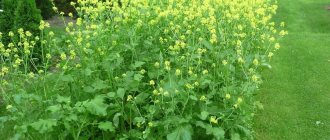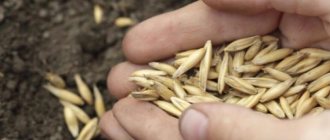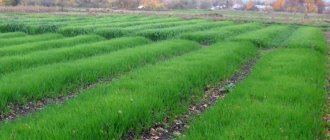Typically, green manure plants are treated as useful herbs that enrich the soil with minerals, protecting it from weathering, drying out, weeds, and diseases. But lupins, which are part of the group of legume green manures, not only increase the amount of nitrogen and monohydrogen phosphates in the surface layer of the earth and attract pollinating insects, but also cause a feeling of delight. After all, it is difficult to find another green manure plant that would so decorate any plot of land on which it grew. So, annual lupine is used as green manure.
Lupine candle flowers reach a height of 60 cm. Inflorescences can be of various shades. The round, compound leaves of the plants also have an attractive appearance. The main flowering time is May and June. Repeated flowering will occur in the fall if the wilted flower stalks are cut off in time. The undemanding nature of lupins to growing conditions and their ability to survive in harsh weather conditions no worse than many weeds make it possible to use these beautiful plants as green manure without much effort.
Kinds
Currently, biologists know about several hundred species of lupine - wild and cultivated. Varieties of multileaf lupine are used for growing in flower beds and flower beds. Among them, Rusol hybrids stand out, reaching very large sizes. Their uniform and dense inflorescences have bright shades. These cut lupins will decorate any bouquet and will last a long time in vases.
Only some varieties of annual lupine and perennial lupine are used as green manure crops. Green manures include white lupine, several types of blue angustifolia, and yellow. Lupines reproduce by seeds, which ripen in beans that vary in size, color and shape. Thanks to research by scientists from the All-Russian Research Institute, it has been established that there is a relationship between the coloring of the surface husks of beans and the shade of flowers. White shades of seeds are characteristic of white lupins. Narrow-leaved species with blue flowers are characterized by dark-colored beans.
Sowing
In order for the use of lupine to benefit, the seed material is buried 2-3 cm deep. The sowing instructions are as follows:
- Planting involves loosening the soil. The excavation should be shallow. After which the soil is left alone for 1-2 days.
- No additional steps to apply organic and chemical fertilizers are required. On the contrary, the substances only worsen the germination and action of the plant.
- The selected type of green manure is planted in the furrow to a depth of 4 cm. The rows are made narrow. Row spacing is 15-30 cm.
How to properly tie a postoperative blanket on a cat after sterilization; is it possible to sew it with your own hands?
The seed material undergoes additional processing. It is necessary to slightly damage the shell. Sandpaper or a scarifier is used for this. Approximate calculation of seeds per hundred square meters = 2.5-3 kg.
Of the three annual species, only the blue variety can be sown for the winter. White and yellow lupine are recommended for spring planting. It is important to remember that it applies provided that the land plot will be rested throughout the year.
The only point that is taken into account: in the fall, after mowing and additional processing, the field can be sown with crops that will winter safely.
How does it affect the soil?
Lupine roots go 2-2.5 m deep into the soil, absorb nutrients and moisture from the lower layers of the soil and transfer them to the surface layers of the earth. Green manure not only loosens the soil, but changes its structure and enriches it with biological nitrogen and phosphorus. The most effective use of lupine is on sandy loam and poor soils with high acidity. Thanks to the substances contained in the roots and green parts of lupine, soil deoxidation occurs.
Read our article about the benefits of mulching HERE
Benefit
The green mass and fruits of lupine are used for fertilizing, mulching the soil and feeding herbivores. You can get green food very quickly, because the maximum accumulation of vegetative mass occurs within 45-50 days after sowing the seeds. The seeds contain from 32 to 40% protein, up to 15% fatty acids. At the same time, in terms of the presence of protein compounds, lupine is not inferior to soybean and some legumes.
Lupine is a valuable source of fiber, minerals, carotenoids, and plant carbohydrates. Oil with antimicrobial properties is produced from the seeds. It is used to rejuvenate and treat skin, improve hair condition, activate the immune system, prevent inflammation and malignant tumors.
The aroma of green manure attracts bees. In apiaries located next to lupine fields, the pollen collected by insects contains 70% lupine pollen.
Planting, is it possible to plant in spring?
Lupine is not picky about the type of soil, although heavy loams and peat are not the best choice for it. Before sowing, it is necessary to loosen the soil and remove all plants from the site. There is no need to apply nitrogen-containing fertilizers. It should be planted in the second half of May.
The planting depth will be 3-4 cm. Narrow grooves will be prepared for the seeds. Place them at a distance of 20 cm. The distance between plants will be 10 cm. All these data are approximate, since you need to start from the lupine variety. Find out how to grow horseradish in your garden from seeds here.
The video shows how the cultivation takes place:
You should not plant the planting mother close to the surface. They have a rather dense shell. It is removed better if the seeds are deepened to a good depth.
Annual lupine as green manure
Varieties of annual lupins used for soil greening have different requirements for growing conditions and are used differently by people.
White lupine has relatively low inflorescences up to 30 cm, a cube-shaped fruit with 3-6 white seeds, stems up to 2 m high. White varieties: Desnyansky, Dega, Gamma are self-pollinating heat-loving plants, are not afraid of drought, but require fertilizing and soil treatment. The green mass of white varieties is more often used for livestock feed than for incorporation into the soil.
Varieties of blue self-pollinating lupine are mainly universal, therefore they are used both as green manure and as forage grasses. The stems of narrow-leaved species: Raduzhny, Nemchinovsky, Rozovy399, Belozerny110 and others grow up to 1.5 m. These plants are not afraid of frost, grow quickly, are unpretentious in care, prefer acidic soils. The seeds are covered with a marble pattern and have dark shades.
Yellow lupine can grow up to a meter in height and requires cross-pollination. In Russian conditions, several varieties are planted: Grodnensky 3, Motiv 369, Academichesky 1, Fakel, Peresvet. The seeds of yellow green manure are beige in color, sometimes speckled. This species is demanding on watering and light, grows on neutral soils, can withstand frosts down to -5°C, and is used as a universal plant.
You can read in detail how to use Fitosporin, how to dilute and how to use it in our article HERE
When to sow
Annual lupins give good results if planted in soil free of weeds. In the initial stage of development, the shoots develop slowly and can be absorbed by weeds. Therefore, very often the seeds of these green manures are sown in early summer after harvesting winter cereals, which prevent the development of weeds.
In spring, heat-loving types of lupine can be sown after the average daily temperature has established at least +10 ° C, cold-resistant ones - after the onset of the first positive temperatures. Seeds of cold-resistant species germinate at +5°C. Autumn sowing of green manure is carried out after harvesting garden crops.
Seeding rates
Lupine is planted in rows in moist, loose soil. Before sowing, the seeds are scarified (the shell is broken to speed up germination and increase germination) and pickled. Fundazol, Maxim, and Vincit are used to disinfect seeds. The average seeding rate of lupine per 1 hectare of land is from 1.5 kg. Plant the seeds in the furrows to a depth of 5 cm. The distance between the rows is from 15 cm to 30 cm. The crops are sprinkled with soil. The soil is lightly compacted using a rake or flat cutter. For densely scattered crops, consumption is up to 3 kg per hundred square meters.
Green manure care
Actually, caring for lupine does not present any difficulties, since this plant easily colonizes virgin areas, provided the soil is suitable. To ensure the maximum beneficial effect from growing green manure, lupine is mowed two months after planting. Usually at this time it already has time to bloom and acquire green pods. There is no need to dig up the beds with lupine. It is enough to mow the green mass, chop off the roots with a flat cutter and sprinkle it all with earth. If this happens in dry weather, then watering the beds is mandatory. It would be appropriate to use drugs with effective microorganisms, which can be replaced with herbal infusions.
If for some reason you have delayed harvesting lupines, then it is better to send the cut stems to compost, since they will no longer decompose so well in the ground.
Angustifolia lupine is often planted before the onset of autumn, in the second half of August. It manages to grow quickly, and already at the end of October it can be mowed and lightly buried. You can also leave cut lupine on the surface of the beds until next season.
Lupine grows to the desired state in just a couple of months, which allows you to plant it before autumn (blue lupine)
Interaction with other cultures
Lupine itself is valuable as a green manure, and there is no point in growing it together with other plants of similar purpose. Otherwise, you may end up with a struggle between plantings for the best conditions, and the result of your event will most likely not be as good as expected.
But planting lupine between rows when growing vegetables is a very good solution. In this case, all three types of lupine are also used, but white is the best among them. Just remember to water it at least once a week.
If you plant rye in front of the lupine, this will save the gardener from the problem of weeds competing with it.
In the place where lupine was grown, nightshades (tomatoes, potatoes), pepper, cruciferous (various types of cabbage, radishes, turnips), pink (strawberries, garden strawberries, strawberries) feel great. Legumes should not be planted here, since belonging to the same family causes the presence of common pests and diseases.
Possible difficulties during cultivation
It would seem that what could be easier than growing a weed on your site that feels great in the wild and reproduces at a high rate? However, often in the garden it can suddenly stall and not live up to expectations. But everything has its reasons.
First of all, make sure that you are growing lupine in acidic or at least neutral soil. It will not grow in alkaline soil, so be sure to measure the acidity level of the soil in your area, and then it will become clear whether it is worth using lupine as a green manure.
Before planting lupine, make sure that the soil on your site is acidic and not alkaline.
In the first days and weeks of growth, lupine develops slowly and begins to drown in weeds. However, do not rush to get upset, because as soon as it begins to grow, no weeds will be a hindrance to it. A good idea is to plant lupine after winter rye or wheat, which are famous as weed-inhibiting plants.
Interaction with other plants
Lupine will be a good predecessor for potatoes and tomatoes, various varieties of cabbage, turnips, radishes, peppers, garden strawberries and strawberries. It is planted between the rows of vegetable nightshade crops.
Only legumes cannot be predecessors for lupine, due to the accumulation of common pathogens and pests in the soil. After the rest of the plants, green manure will grow without any problems. Most often, cereal grasses, spring and winter grain crops, and buckwheat are used as lupine precursors. It is grown in the same place no more than once every 3 years.
What type of plant is used as fertilizer?
Of all the varieties of lupine, the narrow-leaved variety is chosen as a fertilizer because of the special substance in the root. The plant is characterized by rapid growth of green mass and development of the root system. It requires minimal maintenance. 2-3 years after planting and plowing narrow-leaved lupine, the top layer of soil is saturated with nitrogen and useful microelements, and a loose soil structure is formed.
Popular varieties used as fertilizer: Vityaz, Smena, Beloozerny, Crystal, Siderat 38, Nadezhda, Snezhet, Raduzhny.
Possible problems
Problems with growing heat-loving white lupine will arise if frosts below -5°C return after germination. These species require watering during drought. Narrow-leaved species will not grow on alkaline, dense, low-permeability soils with close occurrence of soil water. The optimal acidity for blue lupins is 5.0–5.5 pH. They are not sown after rapeseed due to the risk of damage by nematodes. If seeds are sown in areas heavily clogged with seeds and roots of weeds, then additional weeding and loosening will have to be carried out to remove weeds.
Lupine diseases
Susceptible to fungal infections:
- anthracnose;
- rust;
- white rot;
- powdery mildew.
Insects that live on the plant:
- aphid;
- tuberous weevil.
Against fungal spores, it is necessary to use chemical control methods, liming, destruction of affected parts and burning. If white rot appears, only the top part is removed, leaving the root. Disease provoking factors are excess soil moisture.
For parasitic insects, garlic water is enough to spray or water with potassium permanganate in a ratio of 1:10. Water until symptoms disappear.
When to remove green manure
Lupins must be mowed before mass budding and flowering begin, until the stems and pods of the plants begin to harden. Sometimes it takes up to 60 days for young green pods to appear. But under favorable conditions - timely soil moisture and air temperatures within 20-25 ° C, this period is reduced.
Read how to choose a lawn mower for mulch HERE
Reviews
We bought a house with a very neglected garden plot. The weeds grew taller than my head. Somehow we weeded everything and decided that the land needed to be fed with green manure. We chose blue and white lupins for this purpose - both beautiful and useful. The white one had to be watered regularly. Weeding was done throughout the entire area because the weeds did not allow the sprouts to grow. In the end, we won the fight against the weeds; we mowed down the lupins and dug up the ground along with them. The next year we saw how good the potatoes grew in the areas where the lupine grew.
Alexandra, 30 years old, Berezniki
At first, my wife grew only decorative lupins. Then we learned about their benefits as green manure. We tried to sow in the beds after early radishes. In August, after mowing the lupins, we did not embed them in the soil, but sent them to the compost heap. Radishes were again sown in the same beds. It turned out that the autumn harvest turned out to be richer than that collected in the spring.
Andrey, 42 years old, Yalta
With the help of green manure, and we sow not only lupine, but also oats, rye, and phacelia, we obtained quite fertile soil from clay soil. When it’s time to sow lupine, I don’t particularly care for it. The main thing for these handsome green manures is to water them on time. I sow in early spring, then in their place I plant tomato seedlings. I get good yields, the tomatoes don’t get sick, but I still feed them on the leaves, especially when the tomatoes start to set.
Veronica, 58 years old Dobrush
Natalia
Author
Ask a Question
Lupines are beautiful and healthy green manures with fruits that can replace soybeans, feed animals, and improve people’s health. The more gardeners use these plants in their gardens, the more often they can be read about and seen on blogs. There are practically no negative reviews. And most likely this is deserved, because with the skillful use of green manure, they cannot harm either people or the earth. Health to you and your loved ones!
Types and varieties of lupins: one season or several?
Lupine (Lupinus) is a plant of the legume family. Its fruits, with the exception of a few forage species, are bitter and inedible, which is why the culture is often popularly called “wolf beans” (“lupus” is translated from Latin as “wolf”).
Lupine has a powerful taproot. Nodules form on it, in which special bacteria accumulate nitrogen, which enters the soil with air. Therefore, the crop grows well even on poor soils and without fertilizing.
The homeland of the plant is North America. But when it came to Europe at the beginning of the 19th century, it took root here so much that it practically turned into a local wild plant. Dozens of species of lupine grow in nature, which can be divided into two groups - perennial and annual.
Perennial
The vast majority of varieties found in our gardens are breeding forms of multileaf lupine (Lupinus polyphyllus), an unpretentious winter-hardy perennial.
Garden cultivars of L. multifolia form luxurious bushes 80–120 cm high with large palmate leaves collected in a basal rosette. Even without flowers they are decorative. But a bush with blooming dense candles 30–50 cm long looks wonderful. The flowers open gradually from about the end of May, and if faded spikelets are removed in time, flowering can be extended until August.
Garden form of multileaf lupine
For good growth and intensive flowering, lupine needs an open sunny place. The perennial is not demanding in terms of nutrition, but it does not like too dense, waterlogged soil - in it the rhizome is quickly affected by fungal infections and falls out.
The plant is planted in the spring by sowing seeds in open ground. It does not tolerate transplantation well, so it is better to immediately sow the seeds at a distance of 30–40 cm from each other. If you still need to replant, transfer it with a clod of earth so as to disturb the roots less. The same applies to seedlings grown in containers.
Since the plant converts nitrogen supplied by the air, it is important that the soil around it is loose and breathable. Be sure to loosen the soil under the bushes after rain or mulch it with tree bark or decorative gravel.
Fertilizing with manure and nitrogen fertilizers is unsuitable for lupine. From them only foliage will grow and the roots may rot.
Lupine is considered a perennial, but in fact it is a perennial plant that should preferably be replanted every 3-4 years. Adult bushes need to be dug up, young rosettes separated from them, old rotted pieces of root removed and the cuttings transplanted to a new location.
More details about growing perennial lupins can be seen in the video.
As a result of breeding of multileaf lupine, many cultivated varieties were developed. Hybrids of the English originator George Russell and varieties of Dutch selection are especially common in gardens:
- Kronleuchter - a plant up to 100 cm high with lemon-yellow inflorescences;
- Kastellan – soft purple with white splashes, grows well in partial shade;
- Abendglut is a perennial with luxurious dark red inflorescences that bloom in June and decorate the garden for almost 1.5 months;
- Minarette is a compact plant up to 50 cm high with boiling white fragrant flowers;
- Gallery Rosa - a bush 80–100 cm high with pale pink racemes;
- Edelknaben – carmine red, with large peduncles up to 50 cm long.
Annuals
If in your region perennial lupins freeze or fall out due to sudden transitions from frost to thaw, you can grow annual species in the garden.
Most of them have compact bushes with delicate palmate foliage and beautiful racemose inflorescences of various shades. True, the candles are not so large and dense, but no less charming.
There are 5 types of decorative annual lupins in gardens.
- L. hybridus (L. nybridus) is a “team” of annual hybrids and varieties. Among them there are 15-centimeter bushes and plants up to one meter high. Their inflorescences are loose, openwork, 15–20 cm long.
- L. dwarf (L. nanus) is an annual plant with a height of 15 to 50 cm with incredibly beautiful cobalt flowers with a white sail. The first candles bloom at the end of May, the last ones at the end of July. Looks impressive in an array.
Dwarf lupine is an ideal annual for a flower garden in blue and white colors
- L. Hartwegi (L. nartwegii) - differs from other species in that it has cylindrical rather than cone-shaped inflorescences. The color scheme is blue-violet.
- L. microcarpus is a modest compact bush with white-purple flowers. Often grown as green manure.
- L. changeable (L. mutabilis) is a heat-loving species native to Peru. At the tops of the shoot it forms clusters of moth-like flowers similar in color to violets. Blooms throughout June - July.
Changeable lupine - the embodiment of tenderness and grace
Annual lupins are grown by sowing seeds in April - May in open ground. We do not recommend using the seedling method, since seedlings do not take root well after transplantation. If you want to get earlier flowering, it is better to sow the seeds before winter.
Choose sunny places with light loose soil. Like perennials, they do not need intensive nutrition, but if the soil is poor, feed them with complex fertilizers during the period of active growth. There will be more flower stalks and larger flowers.
Because annuals do not have as strong a root system, they are more susceptible to drought and require watering in hot weather.











